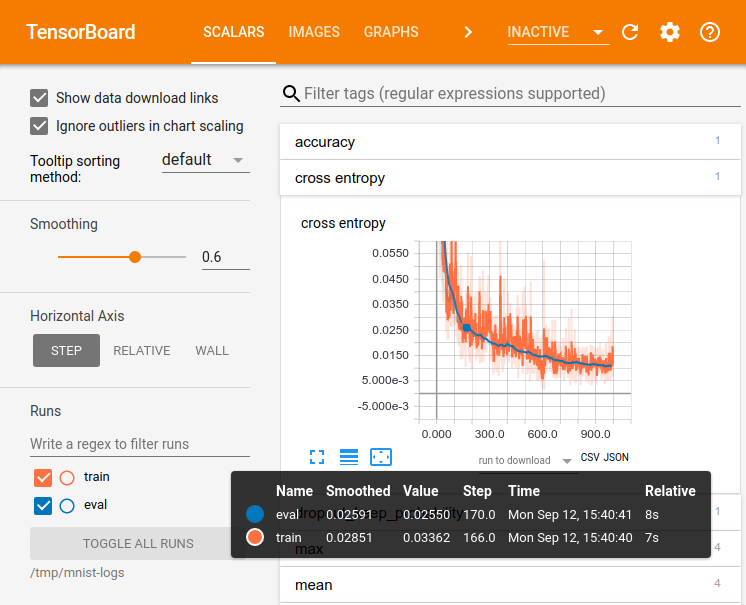您将使用TensorFlow进行的计算 - 如训练大量深度神经网络 - 可能会很复杂且令人困惑。 为了便于理解,调试和优化TensorFlow程序,我们已经包含一套名为TensorBoard的可视化工具。 您可以使用TensorBoard来可视化您的TensorFlow图形,绘制关于图形执行的量化指标,并显示其他数据,如通过它的图像。 当完全配置TensorBoard时,它看起来像这样:

MNIST TensorBoard
本教程旨在让您开始使用简单的TensorBoard。 还有其他资源可用! TensorBoard README有关TensorBoard使用情况的更多信息,包括提示和技巧以及调试信息。
TensorBoard通过读取TensorFlow事件文件进行操作,该文件包含运行TensorFlow时可以生成的摘要数据。 以下是TensorBoard中总结数据的一般生命周期。
首先,创建您想从中收集摘要数据的TensorFlow图,然后决定使用摘要操作注释哪些节点。
例如,假设您正在训练用于识别MNIST数字的卷积神经网络。 您想记录学习率随时间的变化,以及目标函数如何变化。 通过将tf.summary.scalar ops分别附加到输出学习速率和丢失的节点来收集这些信息。 然后,为每个scalar_summary赋予一个有意义的标记,如'学习率'或'丢失函数'。
也许你也想看到从特定层出来的激活分布,或梯度或权重的分布。 通过将tf.summary.histogram ops分别附加到梯度输出和保存权重的变量来收集这些数据。
有关所有可用摘要操作的详细信息,请查看摘要操作上的文档。
在运行它们之前,TensorFlow中的操作不会执行任何操作,或者操作依赖于它们的输出。 我们刚刚创建的汇总节点是图形的外围设备:您当前运行的操作都不依赖于它们。 所以,为了生成摘要,我们需要运行所有这些汇总节点。 手动管理它们将非常麻烦,因此请使用tf.summary.merge_all将它们组合为一个可生成所有摘要数据的操作。
然后,您可以运行合并摘要操作,该操作将在给定步骤中生成包含所有摘要数据的序列化的摘要 protobuf对象。 最后,要将此汇总数据写入磁盘,请将汇总头文件传递给tf.summary.FileWriter。
FileWriter在其构造函数中使用了一个logdir - 这个logdir非常重要,它是所有事件将被写出的目录。 另外,FileWriter可以选择在其构造函数中使用Graph。 如果它接收到一个Graph对象,那么TensorBoard将可视化您的图形以及张量形状信息。 这将使您更清楚地了解流过图表的内容:请参阅张量形状信息。
现在你已经修改了你的图并有一个FileWriter,你就可以开始运行你的网络! 如果你愿意,你可以每一步都运行合并的摘要操作,并记录大量的训练数据。 不过,这可能比您需要的数据多。 相反,请考虑每个n步骤运行合并的摘要操作。
下面的代码示例是对简单MNIST教程的修改,其中我们添加了一些摘要操作,并且每十步执行一次。 If you run this and then launch tensorboard --logdir=/tmp/tensorflow/mnist, you'll be able to visualize statistics, such as how the weights or accuracy varied during training. 下面的代码是摘录;完整的源代码在这里。
def variable_summaries(var):
"""Attach a lot of summaries to a Tensor (for TensorBoard visualization)."""
with tf.name_scope('summaries'):
mean = tf.reduce_mean(var)
tf.summary.scalar('mean', mean)
with tf.name_scope('stddev'):
stddev = tf.sqrt(tf.reduce_mean(tf.square(var - mean)))
tf.summary.scalar('stddev', stddev)
tf.summary.scalar('max', tf.reduce_max(var))
tf.summary.scalar('min', tf.reduce_min(var))
tf.summary.histogram('histogram', var)
def nn_layer(input_tensor, input_dim, output_dim, layer_name, act=tf.nn.relu):
"""Reusable code for making a simple neural net layer.
It does a matrix multiply, bias add, and then uses relu to nonlinearize.
It also sets up name scoping so that the resultant graph is easy to read,
and adds a number of summary ops.
"""
# Adding a name scope ensures logical grouping of the layers in the graph.
with tf.name_scope(layer_name):
# This Variable will hold the state of the weights for the layer
with tf.name_scope('weights'):
weights = weight_variable([input_dim, output_dim])
variable_summaries(weights)
with tf.name_scope('biases'):
biases = bias_variable([output_dim])
variable_summaries(biases)
with tf.name_scope('Wx_plus_b'):
preactivate = tf.matmul(input_tensor, weights) + biases
tf.summary.histogram('pre_activations', preactivate)
activations = act(preactivate, name='activation')
tf.summary.histogram('activations', activations)
return activations
hidden1 = nn_layer(x, 784, 500, 'layer1')
with tf.name_scope('dropout'):
keep_prob = tf.placeholder(tf.float32)
tf.summary.scalar('dropout_keep_probability', keep_prob)
dropped = tf.nn.dropout(hidden1, keep_prob)
# Do not apply softmax activation yet, see below.
y = nn_layer(dropped, 500, 10, 'layer2', act=tf.identity)
with tf.name_scope('cross_entropy'):
# The raw formulation of cross-entropy,
#
# tf.reduce_mean(-tf.reduce_sum(y_ * tf.log(tf.softmax(y)),
# reduction_indices=[1]))
#
# can be numerically unstable.
#
# So here we use tf.nn.softmax_cross_entropy_with_logits on the
# raw outputs of the nn_layer above, and then average across
# the batch.
diff = tf.nn.softmax_cross_entropy_with_logits(targets=y_, logits=y)
with tf.name_scope('total'):
cross_entropy = tf.reduce_mean(diff)
tf.summary.scalar('cross_entropy', cross_entropy)
with tf.name_scope('train'):
train_step = tf.train.AdamOptimizer(FLAGS.learning_rate).minimize(
cross_entropy)
with tf.name_scope('accuracy'):
with tf.name_scope('correct_prediction'):
correct_prediction = tf.equal(tf.argmax(y, 1), tf.argmax(y_, 1))
with tf.name_scope('accuracy'):
accuracy = tf.reduce_mean(tf.cast(correct_prediction, tf.float32))
tf.summary.scalar('accuracy', accuracy)
# Merge all the summaries and write them out to /tmp/mnist_logs (by default)
merged = tf.summary.merge_all()
train_writer = tf.summary.FileWriter(FLAGS.summaries_dir + '/train',
sess.graph)
test_writer = tf.summary.FileWriter(FLAGS.summaries_dir + '/test')
tf.global_variables_initializer().run()在我们初始化FileWriters之后,在训练和测试模型时,我们必须向FileWriters添加摘要。
# Train the model, and also write summaries.
# Every 10th step, measure test-set accuracy, and write test summaries
# All other steps, run train_step on training data, & add training summaries
def feed_dict(train):
"""Make a TensorFlow feed_dict: maps data onto Tensor placeholders."""
if train or FLAGS.fake_data:
xs, ys = mnist.train.next_batch(100, fake_data=FLAGS.fake_data)
k = FLAGS.dropout
else:
xs, ys = mnist.test.images, mnist.test.labels
k = 1.0
return {x: xs, y_: ys, keep_prob: k}
for i in range(FLAGS.max_steps):
if i % 10 == 0: # Record summaries and test-set accuracy
summary, acc = sess.run([merged, accuracy], feed_dict=feed_dict(False))
test_writer.add_summary(summary, i)
print('Accuracy at step %s: %s' % (i, acc))
else: # Record train set summaries, and train
summary, _ = sess.run([merged, train_step], feed_dict=feed_dict(True))
train_writer.add_summary(summary, i)你现在都准备用TensorBoard来显示这些数据。
要运行TensorBoard,请使用以下命令(或者python -m tensorflow.tensorboard)
tensorboard --logdir=path/to/log-directory其中logdir指向FileWriter序列化其数据的目录。 如果这个logdir目录包含包含来自单独运行的序列化数据的子目录,那么TensorBoard将可视化来自所有这些运行的数据。 一旦TensorBoard正在运行,浏览您的网页浏览器到localhost:6006以查看TensorBoard。
在看TensorBoard时,您会看到右上角的导航标签。 每个选项卡代表一组可以可视化的序列化数据。
For in depth information on how to use the graph tab to visualize your graph, see TensorBoard: Graph Visualization.
有关TensorBoard的更多使用信息,请参见TensorBoard README。